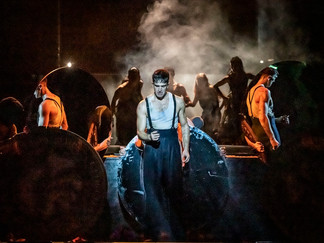Peaky Blinders: The Redemption of Thomas Shelby
- Robert Beale

- Mar 15, 2023
- 3 min read
Benoit Swan Pouffer and Stephen Knight
Rambert Dance
The Lowry, Salford
March 14-18, 2023: 2 hrs 45 min


And so it came to pass that Peaky Blinders: The Redemption of Thomas Shelby, a co-production with The Lowry as well as in association with Birmingham Hippodrome, finally made it to Salford, in a tour that began last September and has only Cardiff and Plymouth to go as fresh venues now.
The publicity has gone before it. First conceived before lockdown and unavoidably marinating for around a couple of years before hitting the UK’s big stages, this spectacular full-length show, based on the TV series, is one of the most lavishly staged, and lavishly hyped, dance creations ever seen.
It’s the brainchild of Benoit Swan Pouffer, Rambert’s artistic director since 2019, and Stephen Knight, the man behind Peaky Blinders on the box (and, you may have noticed, getting credited to the exclusion of Charles Dickens in trailers for writing the forthcoming TV version of Great Expectations).
Think sensory overload, and then double it. The music, part live, is loud – two-thirds of it written specially by Roman GianArthur, the rest the kind of tracks, dark and menacing, used for the small-screen saga. The set design is simple but unusual, with a raised platform with a kind of double frontage, so there’s a catwalk from left to right half-hiding a well, plus a lower front level. The costumes – the one element that sets the piece in its period – are designed by Richard Gellar and superbly made. The lighting is virtuosic, and almost every stage device you can think of - haze, smoke, flashes, explosions, fire - is thrown in. And that’s before we even think about the dancing.
For those who aren’t fans of the TV series (and that includes me), there are pre-recorded bits of narration by Benjamin Zephaniah. They don’t cover every step of the journey (leaving the “caravan scene” and its recycled costumes from a previous show unexplained), but it’s clear that Knight and Pouffer begin with a back-story to the whole scenario, set in the trenches of World War I, to explain how the gangland violence of the 1920s-30s might have had its psychological antecedents. Then we follow Tommy Shelby’s hoodlum story up to the point where he weds, and then loses, nightclub singer Grace.
All that is fast-moving and blow-by-blow, with high bpm counts on the soundtrack. After the interval there’s a change: as Tommy gets hooked on opium, escapes it, returns briefly to turf wars, retires from that and finally discovers a kind of self-acceptance, everything slows down – music, story pacing, the lot; there’s even one three-in-a-bar number, shock horror. Is that a weakness or an invitation to show a more emotional, interpretative style of dance? It depends on your predilections: for contemporary dance newbies it might just be a gateway to discovery.
The choreography, particularly in the first half, has its limitations: it’s vivid and hyperactive, but samenesses are almost inevitable if you don the straitjacket of drum-led rock styles and track-length episodes. You may or may not see wondrous things in the gender-blind allocation of some roles in the story, as well as colour-blindness: with a relatively small company it might be a matter of pure necessity.
But the dance quality is superb – it always is with Rambert – and though it’s invidious to single out one performer, Guillaume Queau as Shelby (he shares the role with Joseph Kudra) has such a key part in the whole that he deserves it. And of course there’s the one-legged dancer Musa Motha, incredibly brilliant.
Peaky Blinders: The Redemption of Thomas Shelby might equally well have been called Peaky Blinders: The Reinvention of Rambert Dance, as Britain’s oldest surviving dance theatre company. Having most recently become something of a niche interest for teenage schoolgirls and a few specialists, curating a somewhat esoteric repertoire called “contemporary dance”, the company now seems ready to gain a new and much wider audience.
The big question, after undeniably achieving it with this show, is: "follow that”.
More info and tickets here











